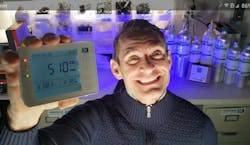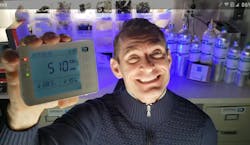Avoiding a virus carried by the air is a Herculean challenge. But companies are finding ways to identify risk in facilities, so workers can take steps to reduce transmission potential.
“It’s not just a matter of having better filters in your air handler, because … by the time it hits the filter, it’s too late,” said Conrad Bessemer, president of Novatec Inc., Baltimore. “It’s gone completely through your system, so, if you’re in a conference room with four or five other people, you have to make the assumption that one of those people is infected.”
MachineSense makes testing equipment, such as thermal detection devices that can be used by plastics processors and others to screen people for fever. Its new protein-detecting devices are set to come out soon, after being tested.
With a warning from the devices, workers or managers would be alerted to the need for further sanitation measures and, possibly, the need to screen individuals who had been in the space where the alarm went off.
Knowing that there are detectable viral levels in the air might prompt workers to open a window, if possible, or motivate facility managers to better enforce physical distancing protocols or invest in more effective air-handling systems.
Directly detecting viruses is only one strategy, though.
Forensics Detectors, a California-based manufacturer of devices that can detect a variety of gases, including carbon monoxide and ammonia, has experienced a four-fold increase in sales of its carbon dioxide (CO2) monitors over the course of the pandemic. They’re useful indicators of how effectively air is exchanged. The more stagnant the air, the more pathogens and toxins that are liable to be floating in it.
“Let’s say we’re exhaling carbon dioxide, and we’re exhaling the moisture, humidity in the forms of these aerosol droplets, micro droplets. Basically, attached to those are all the germs, all the infections, all the pathogens, some bacteria, it could be anything,” said Koz Galatsis, the company’s founder and chief engineer.
With its headquarters near Los Angeles, Forensics Detectors has the advantage of being able to ride trends that radiate out from the country’s largest state. While most of the booming demand for the company’s CO2 monitors has come from gyms, schools and retail establishments like Starbucks, Galatsis said any company where workers interact could benefit from the devices.
“So many factories are good [with] the ventilation system, so you know they probably won’t have a problem with it. But some are working in old premises. You just don’t know until you have these monitors,” Galatsis said. “It gives you that [sense of] safety, right?”
The devices are programmed to trigger an alarm when CO2 concentrations reach 1,100 parts per million — a level Galatsis said scientists consider indicative of transmission risk — but can be reset, as users desire. With the insight the devices provide, users might decide to open windows or doors, increase physical spacing or even invest in better ventilation systems.
Galatsis and Bessemer both emphasized the need to monitor the air in smaller spaces. The new MachineSense products, for example, might be good fits for areas like bathrooms, locker rooms, breakrooms and meeting spaces, which are particularly high-risk, Bessemer said.
While neither the MachineSense nor Forensics Detectors products can stop virus transmission, they can give users an indication of potentially dangerous conditions, just like a smoke alarm.
“You’re going to make air quality the center point for a return to work. Air quality is everything,” Bessemer said.
Galatsis, who earned a doctorate in engineering and has taught at the University of California, Los Angeles, said he’s very optimistic human ingenuity will continue to find ways to address daunting challenges like the pandemic.
“The beautiful thing is humans are super-smart. We sort of improve our situation. We get better and better, right?” he said.
Karen Hanna, associate editor,
Contact:
Forensics Detectors, Rolling Hills Estates, Calif., 424-341-3886, www.forensicsdetectors.com
MachineSense, Baltimore, 443-457,1165, https://machinesense.com
About the Author
Karen Hanna
Senior Staff Reporter
Senior Staff Reporter Karen Hanna covers injection molding, molds and tooling, processors, workforce and other topics, and writes features including In Other Words and Problem Solved for Plastics Machinery & Manufacturing, Plastics Recycling and The Journal of Blow Molding. She has more than 15 years of experience in daily and magazine journalism.



